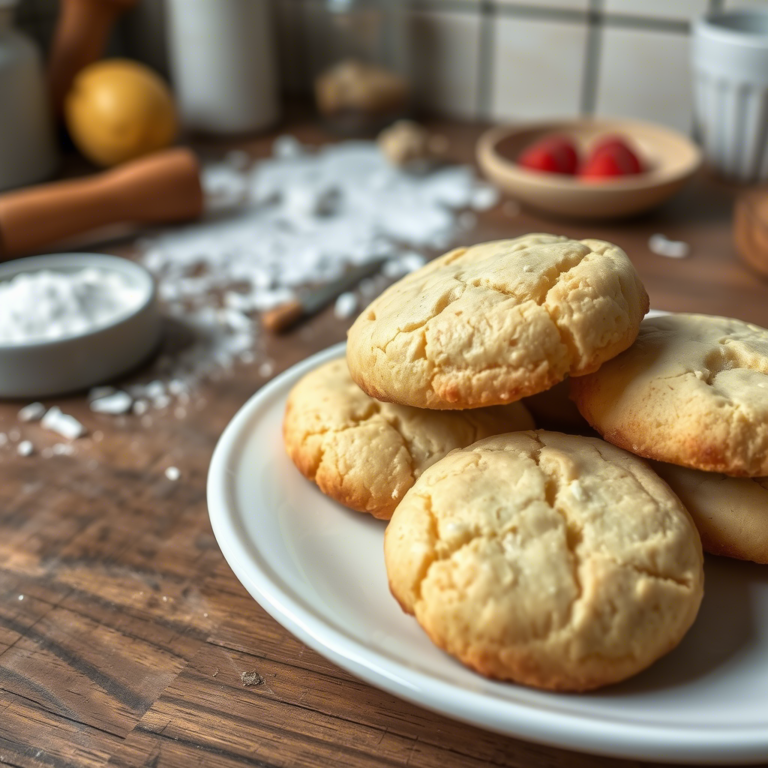Lemon Cookies Recipe: A Zesty Delight with Simple Ingredients
The History and Origin of Lemon Cookies
The Evolution of Cookies
Have you ever wondered where the humble cookie came from? Believe it or not, cookies have ancient roots. Their origins trace back to Persia, long before they made their way to the Western world. In fact, early forms of cookies were more like tiny cakes baked with sugar, flour, and eggs. Fast forward a few centuries, and cookies as we know them were born in Europe, with recipes passed down through generations.

The idea of adding lemon to cookies, though, took some time. Initially, it was more common to see lemon used in savory dishes or beverages. However, over time, as sugar and spices became more accessible, bakers started experimenting with citrus zest in sweet treats. This gradual blending of flavors led to the creation of lemon cookies, which quickly gained popularity for their light, zesty flavor.
Introduction of Lemon in Baking
Lemon has always been a star in the world of baking. It’s zesty, vibrant, and brings a refreshing twist to desserts. But it wasn’t until the 18th century that lemon began to appear more frequently in baked goods. Recipes for lemon cakes and pies started to emerge, each showcasing the fruit’s ability to cut through the sweetness of sugar, creating a delightful balance.
By the 19th century, lemon cookies were making their way into mainstream bakeries. Bakers often paired them with other citrus fruits, or combined lemon zest and juice to create that unmistakable tang. Lemon cookies became a favorite at tea parties, holiday celebrations, and special gatherings, thanks to their bright and irresistible flavor.
As bakers continued to experiment, the variety of lemon cookie recipes expanded. From classic sugar-coated cookies to the more intricate lemon sandwich cookies, the possibilities became endless. In fact, lemon cookies’ flexibility in flavor and texture only added to their growing popularity.
Different Types of Lemon Cookies
1. Classic Lemon Sugar Cookies
When you think of lemon cookies, the classic lemon sugar cookie likely comes to mind. This simple, yet delicious treat brings together the perfect balance of sweetness and zest. With its soft, chewy texture and the fresh burst of lemon flavor, it’s no wonder this variety is a crowd favorite.
To make the classic lemon sugar cookie, the main ingredients include butter, sugar, flour, baking powder, and, of course, lemon zest. The zest is what gives the cookie that punch of citrus, while the sugar creates a perfect contrast. Some bakers opt for a sprinkle of sugar on top of the dough before baking, adding an extra crunchy sweetness.
2. Lemon Shortbread Cookies
Shortbread cookies are typically rich and buttery, with a crumbly texture that practically melts in your mouth. When you add a touch of lemon zest or lemon extract to the dough, you get a refreshing twist on this beloved treat. Lemon shortbread cookies are perfect for those who enjoy a less sweet, more sophisticated flavor profile.
The beauty of shortbread cookies is their simplicity. With just a few ingredients—flour, butter, sugar, and lemon zest—you can create a melt-in-your-mouth experience. They’re often baked into delicate rounds or squares, making them ideal for tea-time treats or an elegant snack.
3. Lemon Drop Cookies
If you’re in the mood for a fun, chewy, and flavorful cookie, lemon drop cookies are a great choice. These cookies get their name from the classic lemon drop candy, known for its bold lemon flavor. Unlike the classic lemon sugar cookie, lemon drop cookies are often more tangy, thanks to the addition of fresh lemon juice.
This variety typically has a slightly crisp exterior, with a chewy and soft center. Some recipes even call for rolling the dough into balls and coating them in sugar before baking, adding a little extra sweetness to balance out the tang.
4. Lemon Biscotti
Biscotti, the classic Italian twice-baked cookie, takes on a citrusy twist when flavored with lemon. Lemon biscotti is crunchy, aromatic, and perfect for dipping into coffee or tea. The addition of lemon zest and sometimes lemon juice gives it a refreshing, tangy bite that contrasts nicely with the crunchy texture of the biscotti.
Bakers often add almonds or other nuts to lemon biscotti, creating a more complex flavor profile. This type of lemon cookie is great for those who enjoy a more substantial cookie with a crisp bite.
5. Lemon Sandwich Cookies
For something a bit more indulgent, lemon sandwich cookies are a fantastic choice. These cookies usually consist of two soft lemon cookies with a creamy lemon filling in the middle. The filling is typically made with butter, powdered sugar, and lemon juice, creating a tangy, smooth contrast to the soft cookie exterior.
Lemon sandwich cookies are perfect for parties or dessert tables, as their cute appearance and fresh lemon flavor are sure to impress guests.
6. Vegan Lemon Cookies
For those following a plant-based diet, vegan lemon cookies are the way to go. These cookies are made without any animal products, such as eggs or dairy, but they still retain that delightful lemon flavor. Vegan lemon cookies often use flax seeds or chia seeds as egg replacements, while dairy-free butter or coconut oil takes the place of traditional butter.
The texture of vegan lemon cookies can be just as soft and chewy as the classic version, and they often use lemon zest and fresh lemon juice to create a bright, citrusy flavor.
7. Lemon Poppy Seed Cookies
For a bit of texture, lemon poppy seed cookies are a great variation. These cookies incorporate the delightful crunch of poppy seeds along with the bright, refreshing taste of lemon. The seeds not only add a fun crunch but also enhance the flavor of the lemon, creating a more complex and enjoyable cookie.
Poppy seeds are a natural pairing with citrus, and when combined with lemon, they create a distinctive flavor combination that’s sure to stand out.
Key Ingredients for Lemon Cookies

1. Lemon Zest: The Heart of the Flavor
One of the most essential ingredients in making lemon cookies is the zest of the lemon. Lemon zest is the thin, outer peel of the lemon, and it contains the oils that provide that vibrant, fresh, and fragrant lemon flavor. It’s packed with citrusy oils that are the secret behind that unmistakable zing.
When using lemon zest, it’s best to use a microplane grater, as this ensures you get only the zest and not the bitter white pith. This ingredient is what makes your cookies shine with that bright, fresh flavor, so be sure not to skip it!
2. Lemon Juice: For a Tangy Twist
While lemon zest provides the essential citrus flavor, lemon juice adds a tangy punch that brings the cookie’s flavor profile into perfect balance. Fresh lemon juice is always recommended over bottled juice, as it has a brighter and more natural taste.
Lemon juice also helps to enhance the dough’s texture by adding a bit of acidity, which can react with the baking soda or powder to create a light and tender cookie.
3. Butter: For Richness and Texture
Butter is a key ingredient in almost all cookie recipes, and lemon cookies are no exception. It provides a rich, creamy texture, helping the dough come together and giving the cookies their melt-in-your-mouth quality. Butter also helps enhance the flavor of the lemon, making the cookies taste even more indulgent.
If you’re looking to create a vegan version, you can substitute dairy butter with plant-based butter or coconut oil. The rich flavor of the butter is still essential, so make sure to choose a good-quality substitute.
4. Sugar: Sweetness and Structure
Sugar is not just about sweetness in cookies; it also plays an important role in the structure and texture of the dough. Granulated sugar is commonly used in lemon cookies to provide sweetness, while some recipes also call for powdered sugar, especially when making frosting or filling for lemon sandwich cookies.
Sugar helps to create that perfect balance between sweet and tangy, and when it’s creamed with butter, it contributes to a light, airy dough that bakes up beautifully.
5. Flour: The Base for Structure
Flour is the foundation of any cookie dough, and for lemon cookies, all-purpose flour is usually the go-to choice. It provides structure to the cookies while allowing them to maintain a soft, chewy, or crisp texture, depending on the recipe.
When measuring flour, always use the spoon-and-level method to avoid overpacking it, which could result in dense cookies. For an even lighter texture, you can experiment with cake flour, which has a lower protein content than all-purpose flour.
6. Baking Soda or Baking Powder: Leavening Agents
The last major component in most lemon cookie recipes is a leavening agent—either baking soda or baking powder. These ingredients help the cookies rise and become light and tender. Baking soda works best in recipes that contain acidic ingredients like lemon juice, as it helps to neutralize the acidity, making the cookies soft and airy.
Baking powder, on the other hand, is a combination of baking soda and an acid, so it can work in recipes where no acidic ingredient is used. Depending on your recipe, either of these agents will ensure your lemon cookies turn out perfectly.
7. Optional Add-ins: Elevating the Flavor
While the classic lemon cookie is delicious on its own, there are plenty of optional add-ins you can incorporate to elevate the flavor and texture. Some popular options include:
- Vanilla extract: A touch of vanilla can enhance the sweetness of the lemon and round out the flavor profile.
- Chopped white chocolate or dark chocolate: Adding small chunks of chocolate gives a decadent twist and pairs beautifully with the tangy lemon flavor.
- Poppy seeds: As mentioned earlier, poppy seeds can add a subtle crunch and depth to the cookies.
- Nuts (e.g., almonds, pistachios): Chopped nuts can add a delightful crunch and complement the lemon’s bright, citrusy flavor.
Conclusion
The key ingredients for lemon cookies come together to create a delicious balance of flavors and textures. From the vibrant zest and tangy juice of the lemon to the rich butter and sweet sugar, each element plays an important role in making these cookies irresistibly tasty. In the next section, we’ll walk through the step-by-step process of making these delightful treats.






